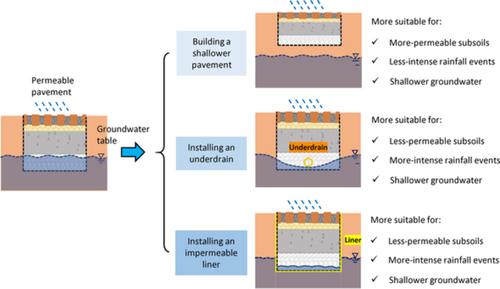当前位置:
X-MOL 学术
›
Hydrol. Process.
›
论文详情
Our official English website, www.x-mol.net, welcomes your feedback! (Note: you will need to create a separate account there.)
Design measures to mitigate the impact of shallow groundwater on hydrologic performance of permeable pavements
Hydrological Processes ( IF 3.2 ) Pub Date : 2020-10-10 , DOI: 10.1002/hyp.13935 Kun Zhang 1 , Ting Fong May Chui 1
Hydrological Processes ( IF 3.2 ) Pub Date : 2020-10-10 , DOI: 10.1002/hyp.13935 Kun Zhang 1 , Ting Fong May Chui 1
Affiliation

|
Permeable pavements (PPs) are widely implemented in urban areas to mimic natural hydrologic processes through enhancing infiltration, and reducing, delaying, and retaining surface runoff. However, its performance can be affected by shallow groundwater since high soil moisture may inhibit its infiltration and exfiltration. This study built a numerical model, which was calibrated and validated based on laboratory experiment data, to evaluate the water balance and retention of PP in shallow groundwater conditions. It assessed the impacts of shallow groundwater and the hydrologic effectiveness of different PP design measures (i.e., building a PP with a smaller storage depth, implementing an underdrain at different elevations, and installing an impermeable liner) on relieving the impacts. Shallower groundwater led to larger amounts of surface runoff and underdrain flow, and a higher chance of saturating the PP reservoir. The three design measures had both benefits and drawbacks in mimicking natural hydrologic cycle and retaining the performance of PP under extreme conditions (e.g., areas of very shallow groundwater tables and/or extreme rainfalls). A PP with a smaller storage depth resulted in less underdrain flow but was prone to saturation. It is, thus, more recommended for PP with more‐permeable subsoils, which can avoid frequent pavement saturation. Although a shallower PP corresponds to a smaller storage volume and shorter hydraulic retention time, it can increase the applicability of PP to shallow groundwater areas, which is beneficial to the regional hydrologic environment. Installing an underdrain generated underdrain flow, which is a burden to the downstream drainage system. However, it significantly reduced the surface runoff and the chance of saturating the PP reservoir, which, thus, is more recommended for PP with less‐permeable subsoils. Comparatively, elevating the underdrain is recommended in areas of shallow groundwater because it can reduce the frequency and amount of groundwater‐induced underdrain flow. In addition, a higher underdrain together with an impermeable liner can create a storage depth, increase the retention duration, enhance exfiltration and evaporation without increasing the saturation risk.
中文翻译:

减轻浅层地下水对透水路面水文性能影响的设计措施
透水路面(PPs)在城市地区广泛使用,以通过增加渗透,减少,延迟和保持地表径流来模仿自然水文过程。但是,由于土壤水分含量高,可能会抑制其渗透和渗出,因此它的性能会受到浅层地下水的影响。这项研究建立了一个数值模型,并根据实验室实验数据进行了校准和验证,以评估浅层地下水条件下PP的水平衡和保持力。它评估了浅层地下水的影响以及不同PP设计措施(即,以较小的存储深度建造PP,在不同高度实施暗渠并安装不透水衬里)对减轻影响的影响。较浅的地下水导致大量的地表径流和暗流,并增加了PP储层饱和的机会。这三种设计措施在模仿自然水文循环并在极端条件下(例如地下水位很浅的地区和/或极端降雨的地区)保持PP的性能方面既有优点也有缺点。具有较小存储深度的PP导致较少的暗渠流动,但易于饱和。因此,对于具有较高渗透性的底土的PP,更推荐使用,这样可以避免频繁的路面饱和。尽管较浅的PP对应较小的存储量和较短的水力停留时间,但可以提高PP在浅层地下水区域的适用性,这对区域水文环境有利。安装排水系统产生的排水系统,这是下游排水系统的负担。但是,它显着减少了地表径流和使PP储层饱和的机会,因此,对于渗透性较低的土壤,建议使用PP。相比之下,建议在浅层地下水区域提高暗渠,因为它可以减少地下水引起的暗渠流动的频率和数量。此外,较高的排水沟和不透水衬里可以形成一个储存深度,增加保留时间,增强渗透和蒸发,而不会增加饱和风险。建议在浅层地下水区域提高暗渠,因为它可以减少地下水引起的暗渠流动的频率和数量。此外,较高的排水沟和不透水衬里可以形成一个储存深度,增加保留时间,增强渗透和蒸发,而不会增加饱和风险。建议在浅层地下水区域提高暗渠,因为它可以减少地下水引起的暗渠流动的频率和数量。此外,较高的排水沟和不透水衬里可以形成一个储存深度,增加保留时间,增强渗透和蒸发,而不会增加饱和风险。
更新日期:2020-12-10
中文翻译:

减轻浅层地下水对透水路面水文性能影响的设计措施
透水路面(PPs)在城市地区广泛使用,以通过增加渗透,减少,延迟和保持地表径流来模仿自然水文过程。但是,由于土壤水分含量高,可能会抑制其渗透和渗出,因此它的性能会受到浅层地下水的影响。这项研究建立了一个数值模型,并根据实验室实验数据进行了校准和验证,以评估浅层地下水条件下PP的水平衡和保持力。它评估了浅层地下水的影响以及不同PP设计措施(即,以较小的存储深度建造PP,在不同高度实施暗渠并安装不透水衬里)对减轻影响的影响。较浅的地下水导致大量的地表径流和暗流,并增加了PP储层饱和的机会。这三种设计措施在模仿自然水文循环并在极端条件下(例如地下水位很浅的地区和/或极端降雨的地区)保持PP的性能方面既有优点也有缺点。具有较小存储深度的PP导致较少的暗渠流动,但易于饱和。因此,对于具有较高渗透性的底土的PP,更推荐使用,这样可以避免频繁的路面饱和。尽管较浅的PP对应较小的存储量和较短的水力停留时间,但可以提高PP在浅层地下水区域的适用性,这对区域水文环境有利。安装排水系统产生的排水系统,这是下游排水系统的负担。但是,它显着减少了地表径流和使PP储层饱和的机会,因此,对于渗透性较低的土壤,建议使用PP。相比之下,建议在浅层地下水区域提高暗渠,因为它可以减少地下水引起的暗渠流动的频率和数量。此外,较高的排水沟和不透水衬里可以形成一个储存深度,增加保留时间,增强渗透和蒸发,而不会增加饱和风险。建议在浅层地下水区域提高暗渠,因为它可以减少地下水引起的暗渠流动的频率和数量。此外,较高的排水沟和不透水衬里可以形成一个储存深度,增加保留时间,增强渗透和蒸发,而不会增加饱和风险。建议在浅层地下水区域提高暗渠,因为它可以减少地下水引起的暗渠流动的频率和数量。此外,较高的排水沟和不透水衬里可以形成一个储存深度,增加保留时间,增强渗透和蒸发,而不会增加饱和风险。



























 京公网安备 11010802027423号
京公网安备 11010802027423号